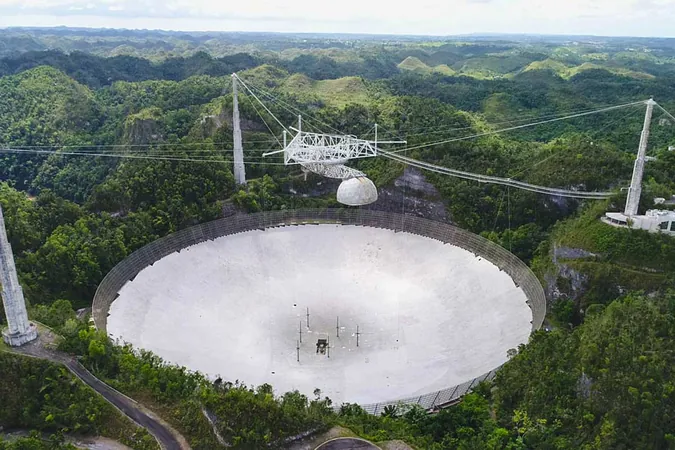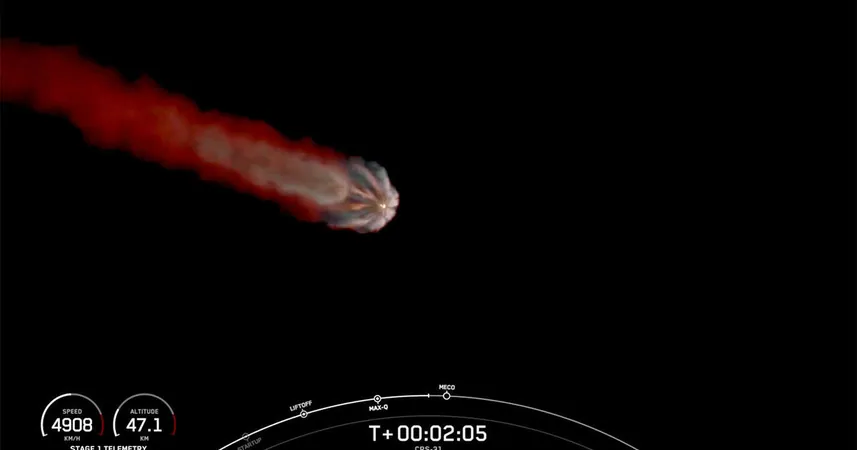
Arecibo Observatory: The Rise and Fall of a Scientific Icon
2024-11-06
Author: Yu
Introduction
In 1963, the Arecibo Observatory began its journey on the enchanting island of Puerto Rico. Standing tall with its massive 305-meter (approximately 1,000 feet) diameter spherical reflector dish, it reigned as the largest radio telescope in the world for over five decades, only to be surpassed in 2016 by the Five-hundred-meter Aperture Spherical Telescope (FAST) in China. However, a tragic incident unfolded in December 2020 when the telescope's reflector dish collapsed following the snapping of several support cables, leading the National Science Foundation (NSF) to announce its decommissioning.
Investigation After the Collapse
In the aftermath, the NSF, in collaboration with the University of Central Florida, embarked on a thorough investigation lasting nearly four years. The findings of the Committee on Analysis of Causes of Failure and Collapse of the 305-Meter Telescope at the Arecibo Observatory pointed to a troubling reality: long-term structural weaknesses exacerbated by a phenomenon known as zinc creep in the telescope’s cable sockets. This deterioration was compounded by the severe damage inflicted by Hurricane Maria in 2017.
Historical Significance and Achievements
Initially conceived as the Arecibo Ionospheric Observatory, the facility was designed to conduct research not just in radio astronomy, but also in ionospheric studies under the auspices of the Advanced Research Projects Agency’s (ARPA) Defender Program, aimed at developing missile defenses. In 1967, the NSF took the reins, transforming Arecibo into a civilian hub for astronomical research, and by 1971, NASA committed to sharing the costs associated with its upkeep. Throughout its illustrious history, the Arecibo Observatory achieved groundbreaking scientific milestones. Notably, it played a pivotal role in the 1974 discovery of a binary pulsar, which earned scientists Russell A. Hulse and Joseph H. Taylor the Nobel Prize in Physics in 1993. Moreover, the observatory was instrumental in the discovery of the binary asteroid 4337 Arecibo in 1985 and the first exoplanets in 1992, forever altering our understanding of the universe.
The Arecibo Message
Perhaps most famously, the Arecibo Observatory produced the Arecibo Message, an ambitious endeavor to communicate with extraterrestrial intelligence. This powerful radio transmission was designed by a team that included the visionary Frank Drake and renowned science communicator Carl Sagan, aimed at the globular star cluster M13—an iconic moment in the search for cosmic life.
Impact of Hurricane Maria
However, the shadows of Hurricane Maria loomed large. The report from the Committee detailed how the hurricane unleashed winds exceeding 105 mph, imposing unprecedented structural stress on the telescope. Incredibly, initial inspections declared the structure intact. Yet, cracks in the integrity became apparent as repairs were delayed, and further inspections failed to reveal the hidden vulnerabilities that ultimately doomed the observatory.
The Collapse and Its Aftermath
By late 2020, following the failure of additional support cables, the NSF prepared for the controlled demolition of the telescope. Sadly, before that plan could be executed, disaster struck on December 1, 2020, as more cables succumbed to the strain and caused a catastrophic collapse of the instrument platform into the dish below. Fortunately, no personnel were injured in this tragic event.
Future Plans for Arecibo
In response to the findings of the report, which emphasized the critical failure of the telescope’s cable spelter sockets and the mismanagement of repairs, the NSF announced new visionary plans for the future of the Arecibo site. In October 2022 and September 2023, statements outlined a transformation of the observatory into a new educational center dubbed Arecibo C3, set to focus on Ciencia (Science), Computación (Computing), and Comunidad (Community).
Legacy of Arecibo
While the era of radio astronomy at Arecibo has drawn to a close, its legacy is far from forgotten. The rebirth of Arecibo as a STEM research and educational hub ensures that its spirit will continue to inspire future generations of scientists and explorers, forging a pathway for discovery on a global scale.


 Brasil (PT)
Brasil (PT)
 Canada (EN)
Canada (EN)
 Chile (ES)
Chile (ES)
 España (ES)
España (ES)
 France (FR)
France (FR)
 Hong Kong (EN)
Hong Kong (EN)
 Italia (IT)
Italia (IT)
 日本 (JA)
日本 (JA)
 Magyarország (HU)
Magyarország (HU)
 Norge (NO)
Norge (NO)
 Polska (PL)
Polska (PL)
 Schweiz (DE)
Schweiz (DE)
 Singapore (EN)
Singapore (EN)
 Sverige (SV)
Sverige (SV)
 Suomi (FI)
Suomi (FI)
 Türkiye (TR)
Türkiye (TR)